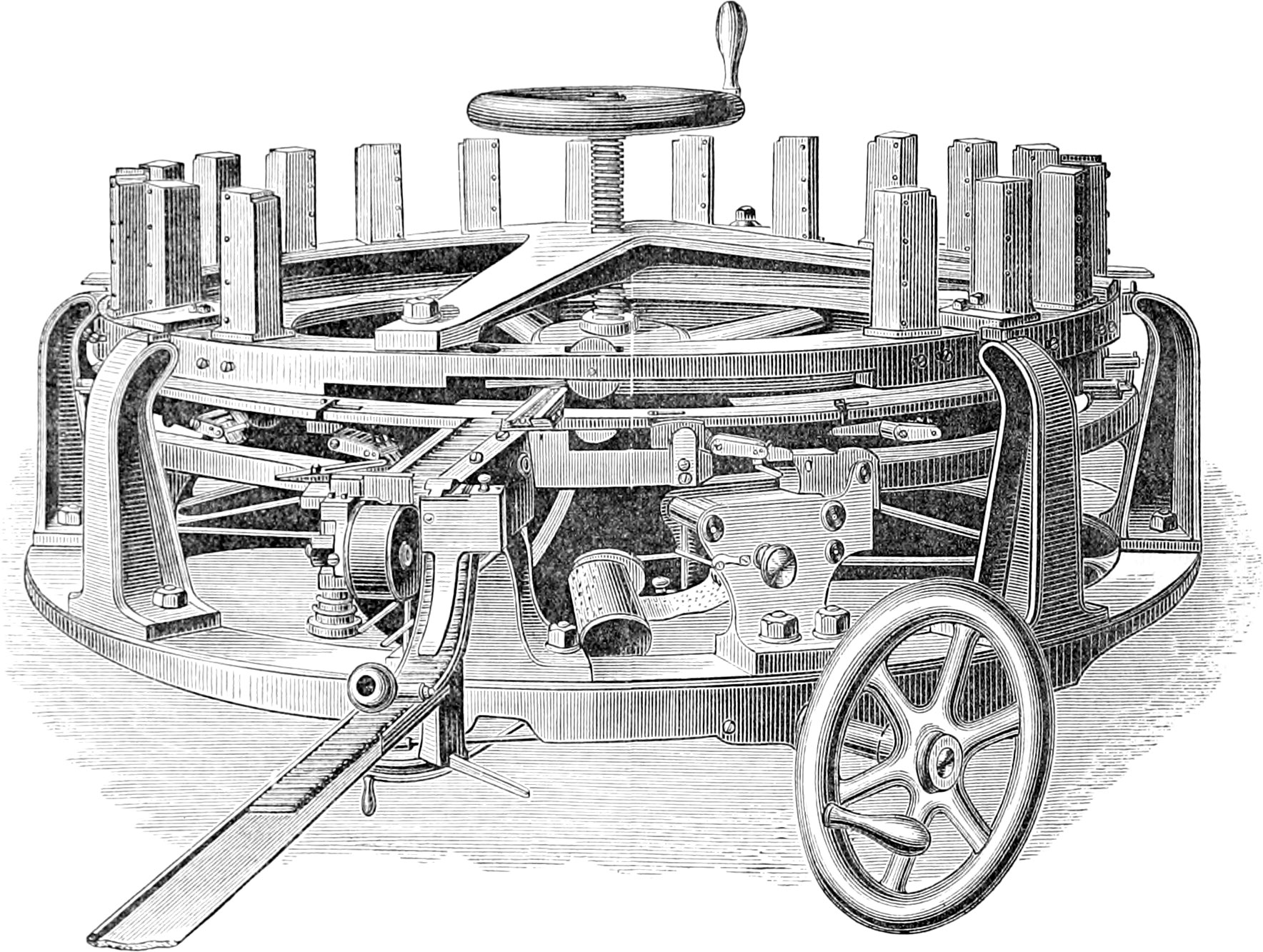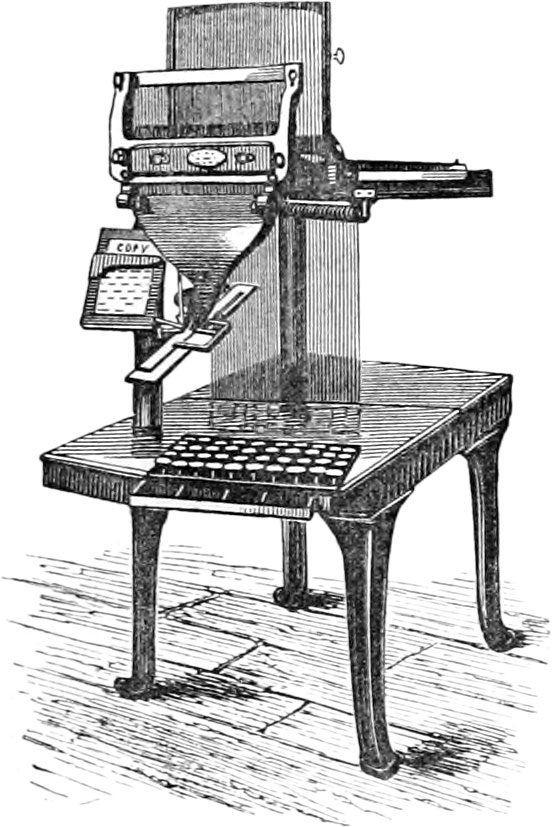Composing machines
Machines for setting types, without manual labour. Many ingenious inventions for this pu[r]pose have been produced in Great Britain, France, and the United States. Almost all of them, however, have been pronounced by practical men to be too complicated and expensive for general use.
The latest is Mr. Mackie’s, of the Warrington Guardian, of which we give an engraving below.

Mr. Mackie has been engaged on this machine several years, but in 1869 he announced that he had actually completed it. It is divided into two parts. One of these is a tiny instrument consisting of fourteen keys, by means of which narrow strips of paper are perforated by girls either in the printing office or elsewhere. The Composing Machine proper consists, practically, of three horizontal rings about 3 ft. in diameter and 2 in. broad, the under one and the top one being at rest.
On the top ring 20 pockets are inserted, each of which contains compartments for seven different kinds of type, to extract the bottom type from any one, or from all the seven divisions, as wanted. The middle or travelling ring has twenty pickpockets, each carrying seven of what are called the “legs-of-man,” and seven fingers.
At the place where the machine may be said to commence operations, there is a drum, about 2 in. in diameter, with 14 perforations across its upper surface, and over this drum the paper, previously perforated, is made to travel by a positive motion of 1-10th of an inch every movement. Over the top of the drum and paper there are 14 levers with pegs, and which are always seeking to enter the perforations in the drum, but are only able to enter those which have corresponding perforations in the paper. One half of the perforations regulate the legs-of-man, and the other the fingers. Two perforations are always made in the paper for the former, and from one to seven for the latter, so that a pickpocket is capable of taking type the same instant out of all the seven divisions of any pocket. On the type being extracted it remains upon the travelling ring till it has reached the delivery channel, when a pusher places it on a travelling belt, a few inches long, from which it is pushed down a syphon spout, one letter upon another, ready for being justified in lines.
A ring carrying 20 pickpockets, each of which has seven fingers, may extract 20 times seven types in one revolution. The composing power of this machine is guaranteed at 12,000 an hour. The perforating can be done at the rate of 10,000 per hours, and the paper used many times. A proof is printed as the type is being set.
The machine is in daily use at the Warrington Guardian office, driven by steam, but it may be driven by hand, as shown in the engraving.—
The only machine which has been practically tested in England for any considerable length of time is one invented by Mr. Robert Hattersley, of Manchester, an illustration of which will be found on the following page. The great merits of this machine are, that it sets up the type very expeditiously, is easily manipulated, occupies little room, and is moderate in price.

It stands on a space of 2 feet by 3, and is worked by touching a keyboard, like that of a piano. Any intelligent operator, after a few weeks’ practice, ought to be able to compose at the rate of 4000 to 6000 types an hour, which is equal to more than the work done by three ordinary compositors. The type used is of the ordinary kind. To the speed of the machine there is no limit whatever. All depends on the dexterity of the operator. The price ranges from £75, at which sum an efficient instrument can be supplied. The Printers’ Register, of September, 1869, says:—
“The Composing Machine is now an accomplished fact. Its precise construction is at present not definitely settled, but as certainly as the next dozen years will come and pass away it is that a Composing Machine will be used in every large printing office. We cannot foresee the effect of this invention, but we may say that it cannot fail to exert a very important influence upon the question of the employment of women as compositors. The machine is specially suitable for female use.”
We have taken some pains to ascertain the real merits of this machine, and we can conscientiously endorse the claims of the inventor, who is a practical mechanic, and has utilised his engineering attainments in the avoidance of many technical defects which have marred nearly all the Composing Machines that have hitherto been introduced. Simplicity is its leading characteristic, and it is a merit of the highest importance.
The type is worked into the composing stick direct, and by only one motion—the advantages of which are obvious. No steam-power is required; the mere pressure of the finger on the keys corresponding to the various letters is all the motive power necessary. The matter is set face upwards, is at all times under the immediate supervision of the operator, and the lines can be as readily manipulated as in the ordinary stick. The composing power is limited only by the degree of dexterity attained by the operator, and the keys have been worked at the rate of 26,000 letters per hour. There are many other distinguishing features about Mr. Hattersley’s machine which entitle it to general adoption.
Composing machines
Machines for setting types, without manual labour. Many ingenious inventions for this purpose have been produced in Great Britain, France, and the United States. Almost all of them, however, have been found to be of no real economy in the composition of general matter.